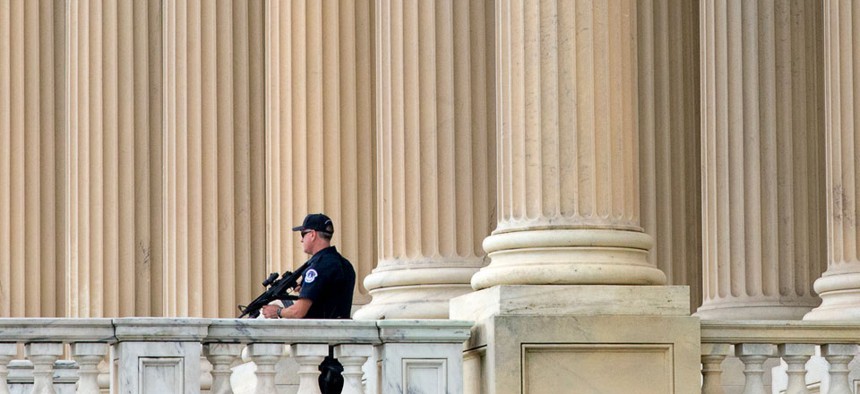
J. Scott Applewhite/AP
Why a Capitol Police Tactical Unit Left the Navy Yard Shooting Scene
Concern about potential threats to the U.S. Capitol led to the pullback.
Uncertainty over whether there were also threats to the U.S. Capitol led to the recall of a specially trained tactical Capitol Police unit from the scene of the nearby Washington Navy Yard shooting rampage, a new fact-finding report states.
A summary of the report released Friday states that Capitol Police officers did "self-deploy" to the Navy Yard area on Sept. 16, about a mile away from the Capitol complex, but that the tactical team had trouble getting there because of traffic. Then, the four members of the Containment and Emergency Response Team were ordered to return to the Capitol "over 30 minutes after the first reports of the attack."
The report comes in the aftermath of reports in the days following the Navy Yard incident that have questioned the Capitol Police leadership's decision to order the emergency response team members to stand down. In the incident, 12 people were eventually killed by a gunman, Aaron Alexis, a former Navy reservist and government contractor, who was himself killed in a police shootout.
After those questions were raised, the U.S. Capitol Police Board at the request of Chief Kim Dine commenced a review of the Capitol Police response to the incident.
The full report and recommendations were described Friday in a shorter summary as "law enforcement sensitive" and therefore were not publicly available.
But the summary says the major focus of the fact review—led by Assistant Senate Sergeant at Arms Michael Stenger, a former assistant director of investigations for the Secret Service—were the actions that day of the emergency response team.
The review team is described as having interviewed dozens of Capitol Police personnel and others, reviewed written reports, radio transmissions, and command-center incident logs.
"The review team chronicled within the scope of their review what is now recognized as a fast–moving, dynamic active shooter incident. Initial reports of the actions of [Capitol Police] personnel were inaccurate and failed to convey the nuanced complexity of such situations including the personal and professional impact on potential first responders," the summary report states.
According to the report, Capitol Police personnel did initially "self-deploy" to the Navy Yard area.
Those included two motorcycle units that assisted in traffic control on M Street SE. In addition, a field sergeant was deployed to the designated police command center at the Navy Yard in order to serve as the Capitol Police liaison. And a third field unit was deployed to the southwest corner of the Navy Yard, where he assisted in providing perimeter security.
In addition, the four-person emergency response unit responded to the vicinity of 11th and M Streets SE.
"Subsequently they were directed to the Navy Yard incident command post, but instructed not to enter the Navy Yard," the summary states. Then, "because of traffic gridlock caused by both emergency vehicles and commuter traffic the CERT unit was unable to reach that incident command post.
"The [emergency response] unit then moved closer to the Capitol, increasing its flexibility to respond as needed at either the Capitol or the Navy Yard," the summary report states.
"Based on the combination of information available to [Capitol Police] command personnel concerning the attack in the Navy Yard, the uncertainty about threats to the U.S. Capitol and absent a request for additional Capitol Police assets," says the summary, "the [emergency response] unit was recalled to the Capitol over thirty minutes after the first reports of the attack."
The fact review team made several recommendations, which will enhance opportunities for the Capitol Police "to improve command and control of personnel, internal communications, mutual aid participation, and after action debriefings."
It then states, "the Members of the [Capitol Police] have every confidence in Chief Dine, the abilities and dedication of the men and woman of the Capitol Police, and the unique qualifications of specialty units such as the emergency response team."
Dine was described as having reviewed the report and concurred in its recommendations.







